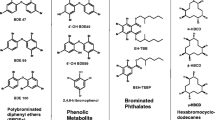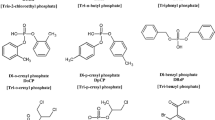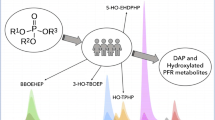Abstract
The first withdrawal of certain polybrominated diphenyl ethers flame retardants from the US market occurred in 2004. Since then, use of brominated non-PBDE compounds such as bis(2-ethylhexyl)-2,3,4,5-tetrabromophthalate (BEH-TEBP) and 2-ethylhexyl-2,3,4,5-tetrabromobenzoate (EH-TBB) in commercial formulations has increased. Assessing human exposure to these chemicals requires identifying metabolites that can potentially serve as their biomarkers of exposure. We administered by gavage a dose of 500 mg/Kg bw of Uniplex FRP-45 (>95 % BEH-TEBP) to nine adult female Sprague–Dawley rats. Using authentic standards and mass spectrometry, we positively identified and quantified 2,3,4,5-tetrabromo benzoic acid (TBBA) and 2,3,4,5-tetrabromo phthalic acid (TBPA) in 24-h urine samples collected 1 day after dosing the rats and in serum at necropsy, 2 days post-exposure. Interestingly, TBBA and TBPA concentrations correlated well (R 2 = 0.92). The levels of TBBA, a known metabolite of EH-TBB, were much higher than the levels of TBPA both in urine and serum. Because Uniplex FRP-45 was technical grade and EH-TBB was present in the formulation, TBBA likely resulted from the metabolism of EH-TBB. Taken together, our data suggest that TBBA and TBPA may serve as biomarkers of exposure to non-PBDE brominated flame retardant mixtures. Additional research can provide useful information to better understand the composition and in vivo toxicokinetics of these commercial mixtures.



Similar content being viewed by others
References
Ali N, Harrad S, Goosey E, Neels H, Covaci A (2011) “Novel” brominated flame retardants in Belgian and UK indoor dust: implications for human exposure. Chemosphere 83:1360–1365
Ali N, Dirtu AC, Van den Eede N, Goosey E, Harrad S, Neels H et al (2012) Occurrence of alternative flame retardants in indoor dust from New Zealand: indoor sources and human exposure assessment. Chemosphere 88:1276–1282
Bearr JS, Stapleton HM, Mitchelmore CL (2010) Accumulation and DNA damage in fathead minnows (Pimephales promelas) exposed to 2 brominated flame-retardant mixtures, Firemaster (R) 550 and Firemaster (R) Bz-54. Environ Toxicol Chem 29:722–729
Bergman A, Rydén A, Law RJ, de Boer J, Covaci A, Alaee M, Birnbaum L, Petreas M, Rose M, Sakai S, Van den Eede N, van der Veen I (2012) A novel abbreviation standard for organobromine, organochlorine and organophosphorus flame retardants and some characteristics of the chemicals. Environ Int 15(49):57–82
Butt CM, Congleton J, Hoffman K, Fang M, Stapleton HM (2014) Metabolites of organophosphate flame retardants and 2-ethylhexyl tetrabromobenzoate in urine from paired mothers and toddlers. Environ Sci Technol 48(17):10432–10438
Calafat AM, Brock JW, Silva MJ, Gray LE, Reidy JA, Barr DB et al (2006) Urinary and amniotic fluid levels of phthalate monoesters in rats after the oral administration of di(2-ethylhexyl) phthalate and di-n-butyl phthalate. Toxicology 217:22–30
Carignan CC, Heiger-Bernays W, McClean MD, Roberts SC, Stapleton HM, Sjodin A et al (2013) Flame retardant exposure among collegiate United States gymnasts. Environ Sci Technol 47:13848–13856
Hoffman K, Fang ML, Horman B, Patisaul HB, Garantziotis S, Birnbaum LS et al (2014) Urinary tetrabromobenzoic acid (TBBA) as a biomarker of exposure to the flame retardant mixture Firemaster (R) 550. Environ Health Perspect 122:963–969
Koch HM, Calafat AM (2009) Human body burdens of chemicals used in plastic manufacture. Philos Trans R Soc Lond B Biol Sci 364:2063–2078
Roberts SC, Macaulay LJ, Stapleton HM (2012) In vitro metabolism of the brominated flame retardants 2-ethylhexyl-2,3,4,5-tetrabromobenzoate (TBB) and bis(2-ethylhexyl) 2,3,4,5-tetrabromophthalate (TBPH) in human and rat tissues. Chem Res Toxicol 25:1435–1441
Silva MJ, Samandar E, Preau JL, Reidy JA, Needham LL, Calafat AM (2007) Quantification of 22 phthalate metabolites in human urine. J Chromatogr B 860:106–112
Silva MJ, Furr J, Preau JL, Samandar E, Gray LE, Calafat AM (2012) Identification of potential biomarkers of exposure to di(isononyl)cyclohexane-1,2-dicarboxylate (DINCH), an alternative for phthalate plasticizers. J Exp Sci Environ Epidemiol 22:204–211
Stapleton HM, Allen JG, Kelly SM, Konstantinov A, Klosterhaus S, Watkins D et al (2008) Alternate and new brominated flame retardants detected in US house dust. Environ Sci Technol 42:6910–6916
Taylor JK (1987) Quality Assurance of Chemical Measurements. Lewis Publishers, Boca Raton
Unitex (2006) Material safety data sheet. http://www.unitexchemical.com/MSDS_CURR/UPLXFRP45_MSDS.pdf. Accessed 25 Jan 2015
US EPA (2013) Polybrominated diphenyl ethers (PBDEs) Significant New Use Rules (SNUR). http://www.epa.gov/oppt/existingchemicals/pubs/qanda.html. Accessed 25 Jan 2015
US EPA (2014) Flame retardants used in flexible polyurethane foam: an alternatives assessment. Draft Report. http://www.epa.gov/dfe/pubs/projects/flameret/ffr-update-complete.pdf. Accessed 14 Oct 2014
Conflict of interest
The authors declare they have no competing financial or other conflicts of interests.
Author information
Authors and Affiliations
Corresponding author
Additional information
Disclaimer: The animal research described in this article has been reviewed by the National Health Environmental Effects Research Laboratory, U.S. Environmental Protection Agency, and approved for publication. Approval does not signify that the contents necessarily reflect the views and policies of the Agency nor does mention of trade names or commercial products constitute endorsement or recommendation for use. The findings and conclusions in this report are those of the authors and do not necessarily represent the views of the Centers for Disease Control and Prevention.
Electronic supplementary material
Below is the link to the electronic supplementary material.
Rights and permissions
About this article
Cite this article
Silva, M.J., Hilton, D., Furr, J. et al. Quantification of tetrabromo benzoic acid and tetrabromo phthalic acid in rats exposed to the flame retardant Uniplex FPR-45. Arch Toxicol 90, 551–557 (2016). https://doi.org/10.1007/s00204-015-1489-6
Received:
Accepted:
Published:
Issue Date:
DOI: https://doi.org/10.1007/s00204-015-1489-6




